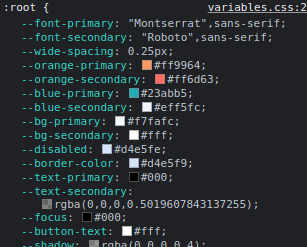Reusing Entities With CSS Custom Properties
Table of Contents
Reusing entities
To declare a CSS variable you will have to add a double dash before the name of that var:
:root {
--green-color: #1B4D3E;
}
To use the value of the CSS variable, we can use the var function:
.green-component {
background-color: var(--green-color);
}
Adding Dark Mode
Create a file called _variables.scss, so you can set up all CSS variables. Then import that file into your main styles.scss using Sass partials.
:root {
--font-primary: 'Montserrat', sans-serif;
--font-secondary: 'Roboto', sans-serif;
--wide-spacing: 0.25px;
--bg-primary: #f7fafc;
--bg-secondary: #ffffff;
--border-color: #d4e5f9;
--text-primary: #000000;
--text-secondary: #00000080;
--focus: #000000;
--shadow: rgba(0, 0, 0, 0.4);
--invert-color: none;
}
.dark {
--bg-primary: #000000;
--bg-secondary: #111014;
--border-color: #2a3139;
--text-primary: #ffffff;
--text-secondary: #999999;
--focus: #ffffff;
--invert-color: grayscale(1) invert(1);
}
Then, in your JavaScript logic, you can add the class dark to the html tag. In React you can do something similar to this:
// if theme is 'dark' then class is 'dark', if not then class is empty
useEffect(() => {
document.getElementsByTagName('html')[0].classList.toggle('dark', theme === 'dark')
}, [theme])
Using Inspector
To check CSS variables, open the Inspector for your web browser (right-click a page and select Inspect) and scroll down until you see something like this:

You can change these values on the browser to test different styles more easily.
